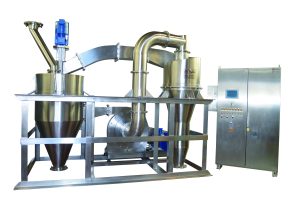Throughout Bradley Pulverizer’s history, we have collaborated with leading research institutions on particle milling and air classifying research initiatives and presentations.
Recently, the prestigious Wolfson Centre at the University of Greenwich partnered with us on a very exciting project involving the use of the Bradley Stainless Steel Windsifter Air Classifier. This project is significant for its focus on standalone air classification equipment, an often under-appreciated factor for meeting stringent specifications and increasing yields. This research provides scientific data to support important advancements in air classifier design. The study focuses on improving efficiencies of ultra-fine powder classification across protein shifting plant-based proteins to produce meat substitute. Improving the sharpness of cut of fine particle powders and high value materials can play a role in meeting stringent specifications and yield requirements across a variety of industries.
Zaki Hussaini, MEng, Design Engineer at Bradley Pulverizer, is a PhD candidate and researcher on this project.
The following is reproduced from the University of Greenwich, Wolfson Centre for Bulk Solids Handling Technology.
This project is led by Dr Baldeep Kaur, with Professor M Bradley and Dr Atul Sharma
Researcher: Zaki Hussaini
The aim of the project is to improve the sharpness of cut of air classifiers with very fine particles, by combining detailed scientific study and modelling of the gas-solid dynamics with empirical test and refinement.
31% of global warming effects arise from food production, 18% from meat. Plant based diets could reduce this greatly but the nature and proportion of proteins in plant materials as grown are not satisfactory to produce meat substitutes acceptable to most consumers. Protein-shifting though not new, has suddenly become a disruptive technology that could overcome this barrier, by processing plant materials especially legume flours to select and refine the proteins that make high quality, widely-acceptable meat substitutes.
Protein shifting requires the plant material to be milled very fine then classified by size. Milling can be achieved but classification to select the extremely fine size, desirable proteins is not currently possible without producing large amounts of waste (much desirable material thrown away in over-size). Successful and economical protein-shifting requires a higher level of selectivity (“sharper cut”) in the ultrafine size range (5 – 10 microns).
The only physically possible technology for separating powders by size in this range in the necessary quantities is air classification although to date there has been little detailed scientific research into air classifier design.
Bradley Pulveriser Enterprises, who are sponsoring this project, has already undertaken some CFD modelling to inform improvements in design of their air-classifiers, with good results. This has strong promise in moving the limits of air classifier technology towards the goal.
The same limitation with current air classification technology is also a stumbling block for large scale production of improved batteries for electric vehicles; quicker charging and higher charge capacity require finer particles but these require a narrower “cut” of sizes than currently achievable. It also has the potential to facilitate dust removal from fine metal powders for additive manufacturing.

